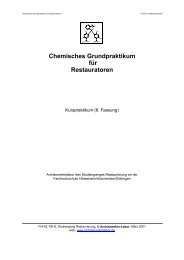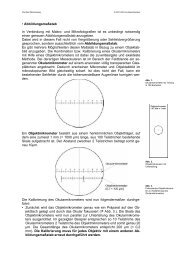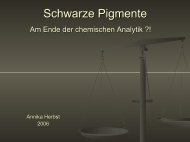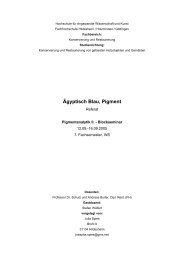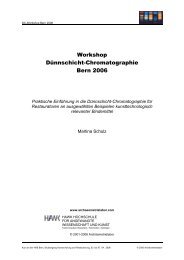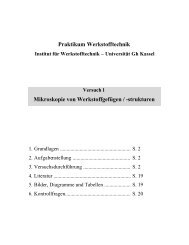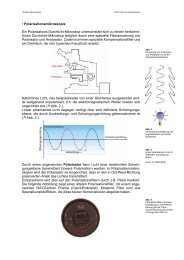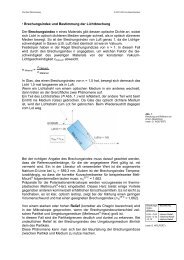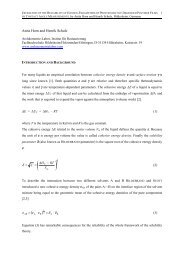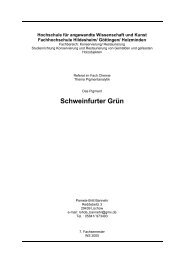Henrik Schulz* and Anita Horn, Archäomertrie-Labor der HAWK ...
Henrik Schulz* and Anita Horn, Archäomertrie-Labor der HAWK ...
Henrik Schulz* and Anita Horn, Archäomertrie-Labor der HAWK ...
Create successful ePaper yourself
Turn your PDF publications into a flip-book with our unique Google optimized e-Paper software.
Manuscript, H. Schulz <strong>and</strong> A. <strong>Horn</strong>, Hildesheim, henrik.schulz@archaeometrielabor.com 16<br />
materials ranged below 100 mN/m. Wood as a highly functional surface (for example by the<br />
hydroxy group of the cellulose molecules, see also Figure 5) st<strong>and</strong>s between the low- <strong>and</strong><br />
high-energy materials, especially after plasma treatment. Thus, a freshly treated wooden<br />
surface that exposed to an ordinary environment (e.g. moisten air) tends rapidly to be covered<br />
with a film of adsorbed water. Therefore we should expect a remarkable value of the<br />
spreading pressure π [18a]. All these phenomena are summarized in Table 1. Let us compile<br />
the essentials of the given models of adsorption again:<br />
1). The total number N0 of surface groups are fairly constant <strong>and</strong> not influenced by the<br />
plasma treatment of the surface:.<br />
π0,V ≈ π0,LV ≈ π1,LV<br />
2.) n-hexane is accepted to adsorb only statistically, because there are no polar functional<br />
groups in the outer fluid that could arrange interaction with the polar surface of the<br />
wood; so no specific adsorption take place:<br />
π0,H ≈ π0,LH ≈ π1,H ≈ π1,LH<br />
3). The plasma treatment strongly increases the number ∆N of activated functional groups<br />
onto the wooden surface, ∆N = N0 − N,<br />
wherein N is the number of remaining inactive <strong>and</strong> saturated surface groups by<br />
adsorption.<br />
4.) The number of activated functional groups ∆N is proportional to the change of the<br />
spreading pressure, ∆π = π0,V − π1,V:<br />
∆π ~ ∆N<br />
5). γS,0 = γS,1<br />
In both cases (per definition) the surface is “bare” (total empty), there is no adsorption<br />
at all.<br />
6). Although the interaction between the surface (functional groups) <strong>and</strong> the wetting liquid<br />
is very sensitive to the polar <strong>and</strong> hydrogen bonding forces the change in γSL before <strong>and</strong><br />
after the plasma treatment is negligible because of the nearly constant surface<br />
concentration of functional groups at all (no additional new kind of surface groups will<br />
be created by the plasma treatment <strong>and</strong> the absolute number of them remain constant):<br />
In other words: If the interaction parameter φ for a series of test liquid is constant, the<br />
change in γSL disappears:<br />
∆γSL = γSL,0 − γSL,1 = 0



